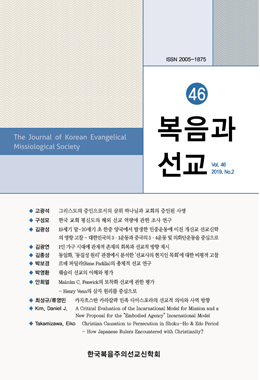이 글은 키리쉬탄들(Kirishitans: 전 근대 시기, 핍박 하에 있었던 일본인 로마 카톨릭 신자들)이 17세기와 19세기에 극심하게 박해와 순교 당했던 때의 일본의 전 근대사를 개요한다. 세 명의 일본 통치자, 오다 노부나가, 도요토미 히데요시와 도쿠가와 이에야스가 키리쉬탄들을 심하게 박해하고 나라의 고립으로까지 이르게 했던 기독교와의 만남을 어떻게 가졌는가가 주된 초첨이다. 선교사들에게 그들의 신앙을 선전하도록 허용한 노부나가의 관대함은 그들의 신실한 신앙과 그들을 통한 교역의 혜택에 대한 관심과 감사와 관련이 있었다. 그러나, 노부나가는 결단코 기독교로의 회심은 커녕 그의 마지막 순간에는 자기 자신을 신격 화하여 그의 백성들로부터 숭배를 요구했다. 다음 통치자, 히데요시는 노부나가가 선교사들과 가졌던 호의적인 관계를 계승했고, 선교사들이 군함을 제공한다는 조건으로 그들의 기독교 보급을 허용했다. 선교사 케일유(Coelho)는 그 협상을 지키지 않았다. 히데요시는 또한 규슈 지역의 많은 다이묘(daimyos: 지역 통치자들)들이 키리쉬탄들이 되고 나가사키를 교황에게 헌납한 것을 알게 되었다. 이러한 일본에서의 기독교의 영향력을 알게 되면서 히데요시는 선교사들에 대한 태도를 바꾸고 그들을 추방했다. 예수회 사람들(Jesuits)에게 주어진 공개 설문지는 선교사들에 의해 중계된 노예 무역과 함께 그들의 배타적인 가르침과 공격적인 신앙의 선전에 관한 것이었다. 따라서, 히데요시는 선교사들을 금했고 최초의 박해로서 26명의 선교사들과 키리쉬탄들을 나가사끼에서 죽이기 위해 체포하였다. 세번째 통치자, 이에야스는 선교사들의 정치적인 의제를 분명히 잘 알고 있었고 선교사들 간의 내부적 갈등을 관찰했다. 이에야스는 로마 카톨릭 선교사들로부터 종교 보급을 강조하지 않는 개신교 나라들, 즉, 네덜란드와 영국에서 온 선교사들로 교역의 파트너를 바꾸었다. 그러나, 그는 로마 카톨릭 선교사들과 신자들의 굴하지 않는 선교 활동을 알아차리고 이에야스와 도쿠가와 왕조의 그의 계승자들은 전국가적 차원에서 기독교에 대한 잔혹한 캠페인과 기독교에 대한 고립 정책을 취했다.
분석을 위한 여섯 가지 요점이 관찰되었다. (1) 정치적이고 경제적인 이슈와 뒤얽힌 기독교 선교는 복음과 선교의 순수성을 훼손했다. (2) 크리스천의 정직성에 문제를 제기하는 크리스천 행동들은 단호한 거절로 연결될 수 있다. 키리쉬탄 다이묘들(Kirishitan daimyos)의 공격적인 행동과 노예 무역의 선교사 관여는 기독교 미션에 대한 의심과 의혹들을 불러 일으켰다. (3)크리스천들 간의 내적 갈등과 경쟁은 일본인 통치자 사이에서 의구심을 강화시켰다. 오늘날의 선교 활동은 어떠한 형태로든지 크리스천들 간의 내적 갈등으로부터 자유한가? (4) 기독교 선교사들과 신자들의 거들먹거리는 태도는 일본 통치자들로 하여 결국 기독교를 거부하게 하는 부정적 결과를 야기시켰다. (5) 센노 리큐(Senno Rikyu)에 의해 개발된 와비차(Wabi Cha)에서 관찰된 상황화(contextualization)는 히데요시를 분노케 하여 선교 활동을 금하게 했을 수 있다. 이것은 오늘날의 선교 방법인, 소위 선진화된 상황화란 이름의 내부자 운동(Insider Movement)이 속임으로 간주될 수 있다는 것이다. (6) 죽음에까지 이르는 믿음을 보여준 선교사들과 키리쉬탄 순교자들의 진정한 헌신은 일본 당국에게는 위협이었고 동시에 강력한 증언과 기독교 신앙의 소망이었다.
This article is an overview of the Pre-modern history in Japan when Kirishitans were severely persecuted and martyred in 17th and 18th century. The primary focus is on how three Japanese rulers, Nobunaga Oda, Hideyoshi Toyotomi and Ieyasu Tokugawa encountered with Christianity that led to the atrocious persecution of Kirishitans and seclusion of the nation. Nobunaga’s generous permission to missionaries for their propagation was related to his interests in and appreciation for their sincere faith and the trade benefits through them. However, Nobunaga was never converted to Christianity, rather, at his last moment he deified himself and demanded worship from his people. The next ruler, Hideyoshi, succeeded Nobunaga’s favorable relationship with missionaries, and he granted permission for the missionaries to propagate Christianity with the conditions that missionaries would provide military ships. The missionary Coelho did not fulfill the negotiation. Hideyoshi also found out that many daimyos in Kyushu area became Kirishitans and dedicated Nagasaki to Pope. Knowing these Christian influences in Japan, Hideyoshi changed his attitude toward missionaries and expelled them. The public questionnaire given to Jesuits were about their exclusive teaching and aggressive propagation as well as the slave trade mediated by missionaries. Thus, Hideyoshi banned missionaries and arrested 26 missionaries and Kirishitans to martyr in Nagasaki as the first persecution. Ieyasu, the third ruler, was clearly aware of the missionaries’ political agenda and observed the internal conflicts among the missionaries. Ieyasu had shifted the trading partners from Roman Catholic missionaries to the ones from Protestant nations, Dutch and England, who did not emphasize religious propagation. However, he realized the resilient missionaries’ activities by Roman Catholic missionaries and believers, Ieyasu and his successors in Tokugawa Dynasty took atrocious nationwide campaign of Christianity and the seclusion policy against Christianity.
Six points for analysis are observed. (1) Christian mission, which was intertwined with political and economic agenda, damaged the genuineness of the Gospel and Mission. (2) Christian actions that question their integrity can lead to total rejection. Aggressive actions by Kirishitan daimyos and the missionaries and their involvement in slave trading caused suspicions and doubts about Christian Mission. (3) The internal conflicts and competition among Christians caused the suspicion intensified among Japanese rulers. Are Today’s Mission activities free from any form of internal conflicts among Christians? (4) Condescending attitude by Christian missionaries and believers caused the negative consequence by Japanese rulers that eventually led to the rejection of Christianity. (5) The contextualization observed in “Wabi Cha” developed by Senno Rikyu might have caused Hideyoshi to anger and ban mission activities. This gives a question to today’s mission method, the advanced contextualization named, Insider Movement, could be regarded as deception. (6) Genuine commitment of the missionaries and Kirishitan martyrs who demonstrated their faith until their death was threat to the Japanese authority, but at the same time strong witnesses and hope in the Christian faith.




